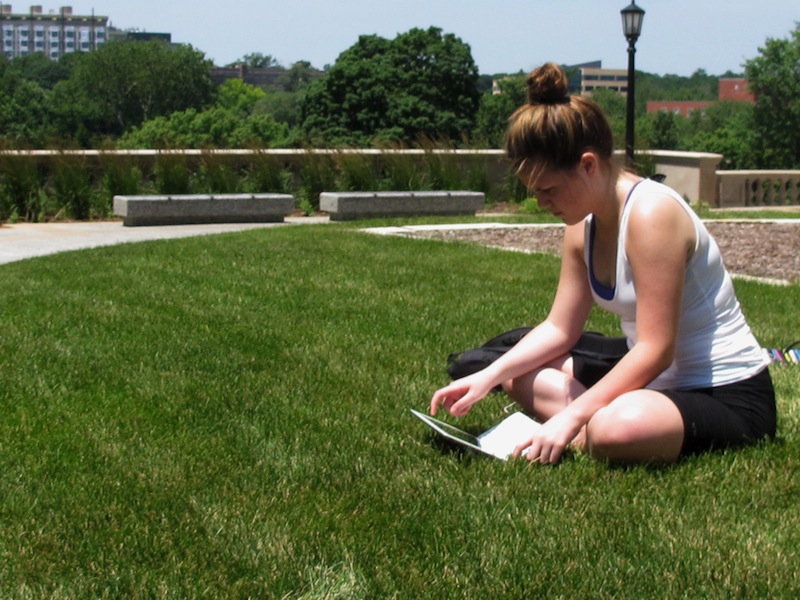PORTLAND – Audrey Allen of Portland feels lucky that she completed her four-year degree in elementary education at the University of Maine with only about $7,500 in student loans.
And since graduation, she has taken advantage of the Educators for Maine program, which rewards graduates who stay in Maine to teach by repaying some or all of their federal student loans.
“But I have several friends that are $60,000 or $80,000 in debt,” said Allen, 25. “They are making payments just on the interest. I can’t imagine.”
On Monday, borrowing money for college got more expensive. The interest rate for federally subsidized Stafford loans for undergraduates doubled from 3.4 percent to 6.8 percent.
Congress postponed the increase last year, when the rate was set to go up, but took no action this year to prevent the increase on July 1.
An estimated 7 million college students nationwide stand to pay the higher rate on future loans. The rate remains 3.4 percent for any subsidized Stafford loans they already have taken out. It remains 6.8 percent for unsubsidized Stafford loans.
Congress may act later this month to reverse the increase, but it has not yet come to an agreement on how to establish interest rates for the loans.
A bipartisan group of lawmakers that includes U.S. Sen. Angus King of Maine is working on a deal. Senate Democrats hope to extend the 3.4 percent rate for another year, while House Republicans have said they want a long-term solution to keep rates low but allow them to rise in the future.
It’s likely that if Congress acts to lower the rate, it will be retroactive to July 1.
The impact of Monday’s rate increase could be widespread in Maine.
In 2011, more than 70 percent of the students who graduated from Maine’s public and private colleges had student loan debt. The average amount was $26,046, which put Maine 18th in the nation, according to a state-by-state report by the Project on Student Debt.
Nationally, the average student debt jumped from $15,073 in 1993 to $27,547 in 2011. This week’s rate increase — coupled with the ever-increasing cost of tuition — is certain to push that average higher for current and future college students.
A $10,000 loan paid back over 10 years would cost $1,810 in interest at 3.4 percent, and $3,809 at 6.8 percent, a difference of $1,999.
Yarmouth High School Principal Ted Hall said that when school officials met with parents and students to talk about financial aid last fall, the rate increase was discussed as a possibility, but no one was convinced it would happen.
“It’s going to have a huge impact on students’ ability to pay for college, but I still think it’s one of those pills you have to swallow,” Hall said.
Gianna Marrs, director of financial aid for the University of Maine, said her office plans to notify students about the rate change, now that it is official. She said many students already have accepted unsubsidized loans with the 6.8 percent interest rate.
But many 18-year-olds don’t pay attention to the interest rate, Hall said. To them, it’s free money now; they likely won’t think about the debt until six months after college ends, when they must start repaying their loans.
Student loan debt already is affecting recent graduates’ ability to buy homes, start small businesses, begin saving for retirement and even buy vehicles.
From 2005 to 2012, the percentage of men ages 25-34 who lived in their parents’ home rose from 13.5 to 16.9, according to Census Bureau data. For women, the rate jumped from 8.1 percent to 10.4 percent during that time.
Audrey Allen, who won’t be burdened by student loan debt, said she doesn’t think the higher interest rate will make students think twice about attending college, but it might make them think harder about which school they attend.
“Some people want to go out of state or go to that big-name school, but is it worth it?” she said.
Others, she said, may put off college until they earn a little money.
“That might be good, too, so they have a sense of what they want to study,” Allen said. “There are plenty of people who have degrees in fields they were interested in but not ones where they can get jobs.”
Amber Pritchard, 18, of Winthrop said the cost of college, including the higher loan interest rate, has weighed heavily in her plans.
She wanted to go to Unity College to study wildlife management. Instead, she plans to enroll in the culinary arts program at Central Maine Community College in Auburn, where tuition costs less.
Pritchard said many of her friends are in the same situation. Some are thinking of taking a year off, she said. Others are looking at schools overseas, where tuition is cheaper.
Many, though, likely will continue with college plans because it’s still the best option for their future.
Talya Davis, 28, of Boston received her undergraduate degree in biology from Smith College and is set to get her master’s degree in microbiology from Tufts University later this summer.
The current rate on her loans for graduate school is 5.25 percent. The rate on her undergraduate loans is lower, but she could not remember how low.
She will pay back about $15,000 in loans for her education and estimates the monthly payment to be $150.
“If you have a job, it’s not hard to pay that back,” she said. “But not everybody is finding that good-paying job.”
Davis isn’t even going into the job market right away. She plans to be a stay-at-home mom for a while.
Still, she said, she will be glad to have her master’s degree when she does decide to go back to work.
Eric Russell can be contacted at 791-6344 or at:
erussell@pressherald.com
Twitter: @PPHEricRussell
Send questions/comments to the editors.


